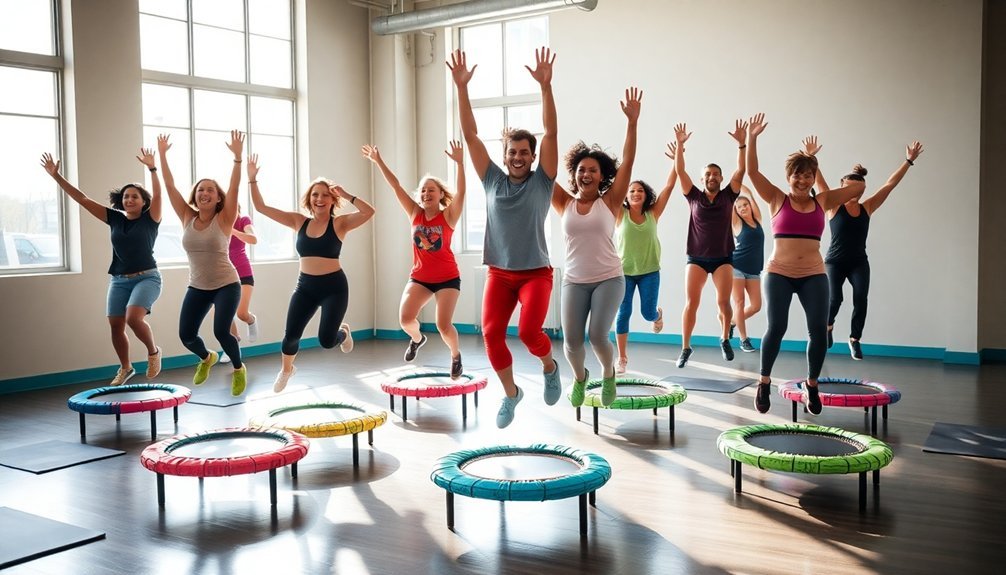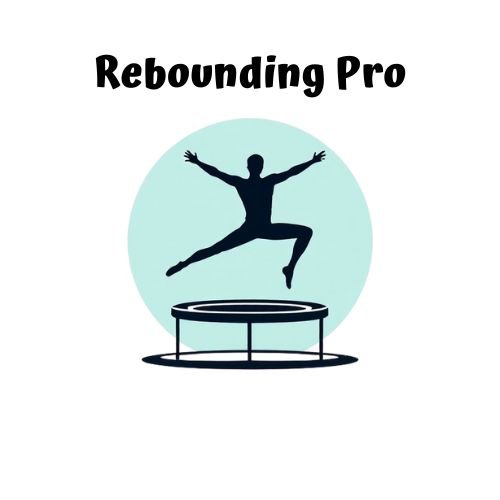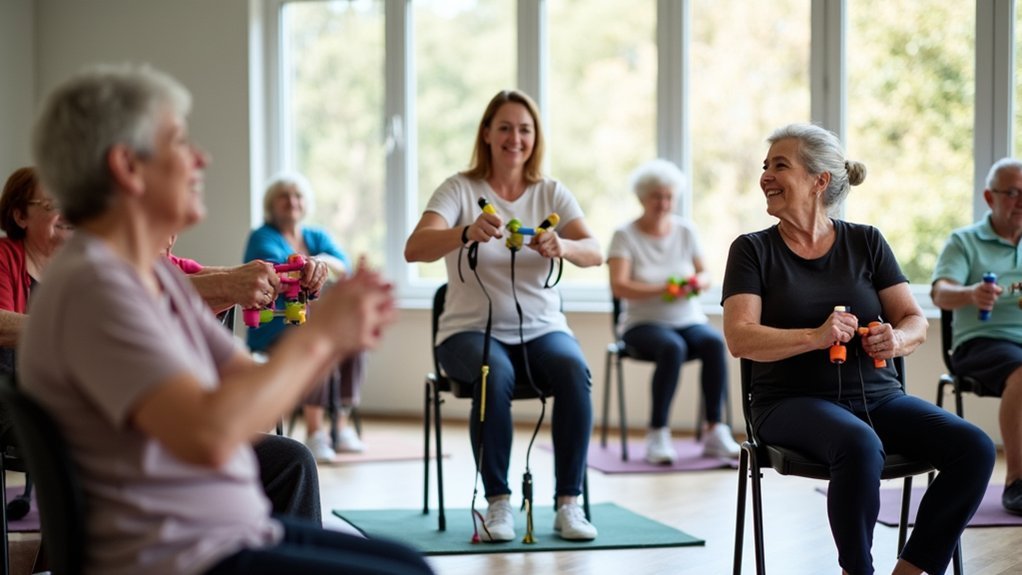The three best low-impact cardio workouts for burning calories are mini-trampoline rebounding, which burns up to 9.4 calories per minute with 80% less joint stress than running; aquatic exercises that provide water resistance while protecting joints; and elliptical training that engages multiple muscle groups simultaneously. You'll maximize calorie burn by incorporating HIIT principles: 45 seconds of intensity followed by 15 seconds of active recovery. Discover how these workouts create the "afterburn effect" that keeps your metabolism elevated for hours afterward.
The Hidden Benefits of Trampoline Workouts for Burning Calories

While many people associate trampolines with childhood fun, they're actually powerful tools for calorie-burning fitness. You can torch up to 700 calories per class depending on intensity, with studies showing trampoline workouts burn calories more effectively than running for the same duration.
Bounce your way to fitness—trampoline workouts can burn more calories than running while feeling like play.
What makes trampolining particularly effective is its combination of aerobic movement with dance-choreographed routines. You'll engage multiple muscle groups simultaneously—glutes, legs, and core all activate as you bounce. Compared to running, trampolining can burn three times more calories while putting less stress on your joints.
This full-body workout improves cardiovascular circulation while being gentler on your joints than high-impact exercises.
The fun factor shouldn't be underestimated either. When exercise feels less like a chore, you're more likely to stick with it consistently, leading to significant improvements in body composition over time.
How Mini-Trampoline HIIT Maximizes Your Fat-Burning Potential
Mini-trampoline HIIT takes the calorie-burning benefits of regular trampoline workouts to an entirely new level. The structured intervals—typically 45 seconds of intense exercise followed by 15 seconds of active rest—keep your heart rate elevated while maximizing calorie burn both during and after your workout.
What makes this approach exceptional is the "afterburn effect"—your metabolism stays elevated for hours post-workout, burning more calories than you'd with steady-state exercises like jogging. Studies show mini-trampoline HIIT can burn 25-30% more calories compared to traditional cardio exercises like running or biking.
By incorporating dynamic movements like squat jumps, high knees, and twists, you'll engage your entire body while enjoying 80% less joint impact than traditional cardio.
You can easily adapt the intensity based on your fitness level, making mini-trampoline HIIT accessible whether you're just starting out or looking for a challenging workout.
Low-Impact Rebounding Routines That Torch More Calories Than Running

Rebounding workouts might seem playful, but they deliver serious calorie-burning results that can surpass traditional running. At 9.4 calories per minute, you'll match or exceed what you'd burn jogging at 6 mph—without the joint stress.
To maximize your calorie burn, alternate between high bounce techniques for circulation and bounce down positions to engage your core and glutes. Add wrist weights to intensify your workout and boost your metabolic rate. The calories burned during rebounding can be calculated using a simple formula that considers your weight in pounds and duration of exercise.
For ideal weight loss, aim for consistent 20-30 minute sessions while gradually increasing intensity. Your body weight, age, and effort level all affect calorie burn, so push yourself appropriately.
Pair your rebounding routine with a calorie-deficit diet and complementary strength training for sustainable, impressive results.
Frequently Asked Questions
Can People With Knee Injuries Safely Perform Low-Impact Cardio Exercises?
Yes, you can safely do low-impact cardio with knee injuries. You'll benefit from exercises like swimming, cycling, and elliptical training that strengthen surrounding muscles while minimizing joint stress and pain.
How Many Calories Does Rebounding Burn Compared to Swimming?
You'll burn more calories rebounding than swimming. Rebounding burns up to 12.4 calories per minute (about 280 in 19 minutes), while swimming burns only 4.8-6 calories per minute, making rebounding more calorie-intensive.
What Low-Impact Cardio Equipment Works Best for Home Use?
For home use, you'll find under-desk ellipticals, compact rowing machines, and foldable stationary bikes most practical. They're space-efficient, versatile for different fitness levels, and provide effective low-impact workouts without disturbing neighbors.
Are Low-Impact Workouts Effective for Weight Loss Goals?
Yes, low-impact workouts are highly effective for weight loss. You'll create calorie deficits without joint strain, build metabolism-boosting muscle, and maintain consistent exercise routines due to reduced injury risk and better long-term sustainability.
How Often Should I Incorporate Low-Impact Cardio Into My Routine?
You should aim for 2-3 low-impact cardio sessions weekly as a beginner, gradually increasing to 4-5 sessions as your fitness improves. Don't forget to include rest days for proper recovery between workouts.
In Summary
Don't underestimate the power of trampoline workouts for serious calorie burning. You'll protect your joints while potentially torching more calories than traditional running. Start with short rebounding sessions, gradually increasing intensity with HIIT intervals. Your cardiovascular health, balance, and metabolism will thank you. The best part? You're having so much fun bouncing that you won't even realize you're getting an incredible workout.





Leave a Reply